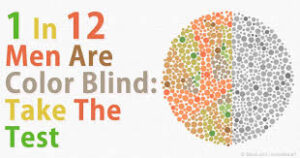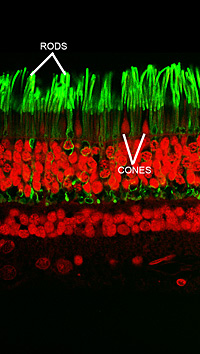
What is colour blindness?
Most of us share a common colour vision sensory experience. Some people, however, have a colour vision deficiency, which means their perception of colours is different from what most of us see.
The most severe forms of these deficiencies are referred to as colour blindness. People with colour blindness aren’t aware of differences among colours that are obvious to the rest of us. People who don’t have the more severe types of colour blindness may not even be aware of their condition unless they’re tested in a clinic.
There are several types of colour blindness: some people do not see red tones (red-green colour blindness) and it’s the most common, others have difficulty with blue or green tones (blue-yellow colour blindness). There are rare cases where a person does not see any of these 3 colours: they see everything in shades of grey. This is because our retinas have 3 types of colour sensitive cells. These cells classify colours as variants of red, blue and green, in long, short or medium luminous waves. In a colour blind person, these cells don’t’ work as they should, causing this disease.
Sometimes colour blindness can be caused by physical or chemical damage to the eye, the optic nerve, or parts of the brain that process colour information. Colour vision can also decline with age, most often because of cataract – a clouding and yellowing of the eye’s lens.
Who gets colour blindness?
Men are much more likely to be colour blind than women because the genes responsible for the most common, inherited colour blindness are on the X chromosome. Males only have one X chromosome, while females have two X chromosomes. In females, a functional gene on only one of the X chromosomes is enough to compensate for the loss on the other. This kind of inheritance pattern is called X-linked, and primarily affects males. Inherited colour blindness can be present at birth, begin in childhood, or not appear until the adult years.

How do we see colour?

Normal Human Retina
What colour is a strawberry? Most of us would say red, but do we all see the same red? Colour vision depends on our eyes and brain working together to perceive different properties of light.
We see the natural and artificial light that illuminates our world as white, although it is actually a mixture of colours that, perceived on their own, would span the visual spectrum from deep blue to deep red. You can see this when rain separates sunlight into a rainbow or a glass prism separates white light into a multi-colour band. The colour of light is determined by its wavelength. Longer wavelength corresponds to red light and shorter wavelength corresponds to blue light.
Strawberries and other objects reflect some wavelengths of light and absorb others. The reflected light we perceive as colour. So, a strawberry is red because its surface is only reflecting the long wavelengths we see as red and absorbing the others. An object appears white when it reflects all wavelengths and black when it absorbs all wavelengths.
Vision begins when light enters the eye and the cornea and lens focus it onto the retina, a thin layer of tissue at the back of the eye that contains millions of light-sensitive cells called photoreceptors. Some photoreceptors are shaped like rods and some are shaped like cones. In each eye there are many more rods than cones – approximately 120 million rods compared to only 6 million cones. Rods and cones both contain photopigment molecules that undergo a chemical change when they absorb light. This chemical change acts like an on-switch, triggering electrical signals that are then passed from the retina to the visual parts of the brain.
Rods and cones are different in how they respond to light. Rods are more responsive to dim light, which makes them useful for night vision. Cones are more responsive to bright light, such as in the daytime when light is plentiful.
Another important difference is that all rods contain only one photopigment, while cones contain one of three different photopigments. This makes cones sensitive to long (red), medium (green), or short (blue) wavelengths of light. The presence of three types of photopigments, each sensitive to a different part of the visual spectrum, is what gives us our rich colour vision.
Humans are unusual among mammals for our trichromatic vision – named for the three different types of photopigments we have. Most mammals, including dogs, have just two photopigment types. Other creatures, such as butterflies, have more than three. They may be able to see colours we can only imagine.
Most of us have a full set of the three different cone photopigments and so we share a very similar colour vision experience, but because the human eye and brain together translate light into colour, each of us sees colours differently. The differences may be slight. Your blue may be more blue than someone else’s, or in the case of colour blindness, your red and green may be someone else’s brown.
What Causes Colour Vision Deficiency?
This condition is often inherited, passed from mother (who is typically a carrier of the gene but not colour blind herself) to son, in which case it will occur in both eyes. Colour vision deficiency caused by injury or illness, which is less common, may impact just one eye. Health conditions that may lead to colour deficiency include:
| Diabetes | Glaucoma | Macular degeneration |
| Alzheimer’s disease | Parkinson’s disease | Multiple sclerosis |
| Chronic alcoholism | Leukemia | Sickle cell anaemia |
Aging can also affect your ability to see colours vividly, as can certain medications, including those used to treat heart problems, high blood pressure, infections, nervous disorders, and psychological conditions.
Blue-green colour blindness is also a known side effect of the erectile dysfunction drug viagra. Exposure to certain chemicals, such as styrene and fertilizers, may also cause a loss of colour vision.
How is colour blindness diagnosed?
 Colour vision testing
Colour vision testing
Eye care professionals use a variety of tests to diagnose colour blindness. These tests can quickly diagnose specific types of colour blindness.
The Ishihara Colour Test is the most common test for red-green colour blindness. The test consists of a series of coloured circles, called Ishihara plates, each of which contains a collection of dots in different colours and sizes. Within the circle are dots that form a shape clearly visible to those with normal colour vision, but invisible or difficult to see for those with red-green colour blindness.
The newer Cambridge Colour Test uses a visual array similar to the Ishihara plates, except displayed on a computer monitor. The goal is to identify a C shape that is different in colour from the background. The “C” is presented randomly in one of four orientations. When test-takers see the “C,” they are asked to press one of four keys that correspond to the orientation.
The anomaloscope uses a test in which two different light sources have to be matched in colour. Looking through the eyepiece, the viewer sees a circle. The upper half is a yellow light that can be adjusted in brightness. The lower half is a combination of red and green lights that can be mixed in variable proportions. The viewer uses one knob to adjust the brightness of the top half, and another to adjust the colour of the lower half. The goal is to make the upper and lower halves the same brightness and colour.
The Pseudoisochromatic Color Test is another red-green colour blindness test that uses colour plates to test for colour blindness.
The Farnsworth-Munsell 100 Hue Test uses a set of blocks or pegs that are roughly the same colour but in different hues (shades of the colour). The goal is to arrange them in a line in order of hue. This test measures the ability to discriminate subtle colour changes. It is used by industries that depend on the accurate colour perception of its employees, such as graphic design, photography, and food quality inspection.
The Farnsworth Lantern Test is used by the U.S. military to determine the severity of colour blindness. Those with mild forms pass the test and are allowed to serve in the armed forces.
Are there treatments for colour blindness?
There is no cure for colour blindness. However, people with red-green colour blindness may be able to use a special set of lenses to help them perceive colours more accurately. These lenses can only be used outdoors under bright lighting conditions. Visual aids have also been developed to help people cope with colour blindness. There are iPhone and iPad apps, for example, that help people with colour blindness discriminate among colours. Some of these apps allow users to snap a photo and tap it anywhere on the image to see the colour of that area. More sophisticated apps allow users to find out both colour and shades of colour. These kinds of apps can be helpful in selecting ripe fruits such as bananas, or finding complementary colours when picking out clothing.
How does colour blindness affect daily life?
Colour blindness can make it difficult to read colour-coded information such as bar graphs and pie charts. This can be particularly troubling for children who aren’t yet diagnosed with colour blindness, since educational materials are often colour-coded. Children with red-green colour blindness may also have difficulty reading a green chalkboard when yellow chalk is used. Art classes, which require selecting appropriate colours of paint or crayons, may be challenging.
Colour blindness can go undetected for some time since children will often try to hide their disorder. It’s important to have children tested, particularly boys, if there is a family history of colour blindness. Many school systems offer vision screening tests that include colour blindness testing. Once a child is diagnosed, he or she can learn to ask for help with tasks that require colour recognition.
Simple everyday tasks like cooking meat to the desired colour or selecting ripe produce can be a challenge for adults. Children might find food without bright colour as less appetizing. Traffic lights pose challenges, since they have to be read by the position of the light. Since most lights are vertical, with green on bottom and red on top, if a light is positioned horizontally, a colour blind person has to do a quick mental rotation to read it. Reading maps or buying clothes that match colours can also be difficult. However, these are relatively minor inconveniences and most people with colour blindness learn to adapt.
